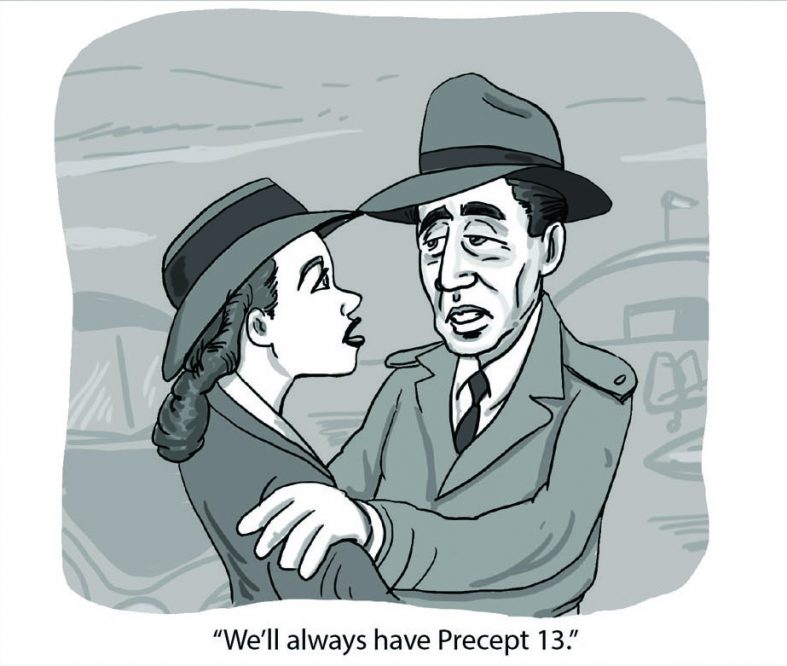By John T. Stokesbury
I am fascinated by the old movies that have been “colorized”—teasing out the real colors from the slight variations in gray used throughout the film. Who would have imagined that you can now watch Casablanca in full color rather than black-and-white! Although it may be anathema to cinematic “purists,” colorizing old movies is welcomed by many because of the sense of realism that color brings to the events portrayed on screen. And yet, decision-makers in many venues are necessarily confined to the assessment of “shades of gray” in reaching important decisions.
As members of the Actuarial Board for Counseling and Discipline (ABCD), we are faced with a wide range of situations. In some, the actions of the subject actuary (that is, the actuary who is the subject of a complaint) are so egregious that a consensus easily emerges among the ABCD members to make a recommendation to the subject actuary’s member organization(s) at the harsher end of the range of disciplines we can propose—suspension or expulsion. For example, few would be surprised if an actuary convicted of securities fraud were recommended for a harsh penalty. Of course, it would be the responsibility of each member organization to consider that recommendation and impose its specific discipline, if any.
In other situations, the ABCD members might consider the violations alleged in a complaint to be so trivial that a material violation of the Code of Professional Conduct could not possibly have occurred, and in such cases the complaint is dismissed. Precept 13 of the Code of Professional Conduct, which defines what constitutes a material violation of the Code, indicates that this is the appropriate outcome.
However, most of the cases that I have seen in my years on the ABCD lie somewhere between these two extremes. In these situations, the members of the ABCD carefully consider the materials presented to them in order to tease out the various nuances and shades of gray in the facts presented. As part of this process, the subject actuary often appears before the ABCD, provides comments to the ABCD, and responds to questions from the members of the ABCD. The subject actuary’s attitude and demeanor are factors the members of the ABCD consider.
To illustrate, let’s consider a number of situations.
In the first case, the complaint stated the subject actuary had issued a report with a number of errors or oversights. The subject actuary appeared before the ABCD and immediately acknowledged that there were indeed errors and oversights in the report, expressed remorse, and apologized for them. In addition, the subject actuary detailed the process the subject actuary followed in reviewing the work of the predecessor actuary, which included the application of reasonableness checks to the measurements, and having the work product peer-reviewed.
In contrast to this, a second case comes to mind that was superficially similar. However, in this case, the subject actuary barely acknowledged that there were errors or oversights in the work product. Rather, the subject actuary gave the impression that errors and oversights in a report were not unusual and may even be the norm. This subject actuary was not able to describe any process of self-review and did not subject the work product to peer review. The subject actuary was also unable to answer some technical questions regarding the subject of the report.
Each of these cases presented a range of factors—some mitigating, some exacerbating—that the members of the ABCD appropriately considered. And while the fact patterns presented in the complaints were similar, the resolution of the cases by the ABCD were affected by consideration of all the shades of gray, and so the outcomes were different. It would hardly be surprising if the complaint against one of these actuaries was upheld, with further action by the ABCD, and the other was dismissed.
In another situation, a complainant alleged that the subject actuary engaged in inappropriate behavior. Without going into details, the behavior in question was something that you wouldn’t want your neighbors to find out about. As you would expect in such a case, the ABCD held a fact-finding hearing at which the subject actuary appeared. During the hearing, the subject actuary argued, in essence, that reports of the behavior were exaggerated and that the behavior that led to the complaint did not amount to a material violation of the Code of Professional Conduct. When responding to questions from ABCD members, the subject actuary appeared to be arrogant and almost defiant. Additionally, the subject actuary was not able to provide the ABCD with various documents that had been requested.
Here again, another case, with similarities, comes to mind that illustrates important differences. In this case, another subject actuary also faced a complaint of inappropriate behavior. This subject actuary also agreed to appear at the ABCD’s fact-finding hearing. In this case, the subject actuary acknowledged the behavior was inappropriate and apologized for it. The subject actuary then outlined the steps taken to reduce the likelihood that the behavior would occur again. We could tell that the subject actuary was truly contrite for the bad conduct.
In yet another case involving a complaint of inappropriate behavior, while the subject actuary did respond to the complaint and submitted a written response to the report prepared by the ABCD-appointed investigator, the subject actuary chose not to appear at the ABCD hearing.
The ABCD was charged, as it is in all cases, to consider all of the materials provided, and to consider any relevant mitigating or exacerbating factors. When it comes to complaints of inappropriate conduct, the behavior of the subject actuary during the investigation process and hearing are significant factors considered. While the three cases described above may appear similar in that inappropriate conduct was alleged, there were nuances in each of them. The members of the ABCD were able to navigate these nuances, appreciating the subtleties of each and reached a different resolution in each—one was fairly light, another harsh, and the third somewhere between the two.
Consistent with Precept 14 of the Code of Professional Conduct,[1] the members of the ABCD consider the facts of each case including the extent to which a subject actuary has been candid and cooperative with the ABCD’s investigation of the complaint.
The members of the ABCD appreciate that our recommendations can have an effect on the subject actuary and the subject actuary’s career. At the same time, the ABCD is mindful that an actuary is expected “to act honestly, with integrity and competence, and in a manner to fulfill the profession’s responsibility to the public and to uphold the reputation of the actuarial profession.”[2] The members carefully consider the entirety of the materials provided (or not) and engage in spirited discussions in order to reach a consensus. It is rare that a case is clearly black or white; rather, the members of the ABCD spend time and energy to appreciate the shades of gray before reaching their decision.
JOHN T. STOKESBURY, MAAA, FSA, FCA, EA, is a member of the Actuarial Board for Counseling and Discipline.
References
[1] Precept 14 of the Code of Professional Conduct, states (in part): “An Actuary shall respond promptly, truthfully, and fully to any request for information by, and cooperate fully with, an appropriate counseling and disciplinary body of the profession in connection with any disciplinary, counseling, or other proceeding of such body relating to the Code.”
[2] Precept 1 of the Code of Professional Conduct.





